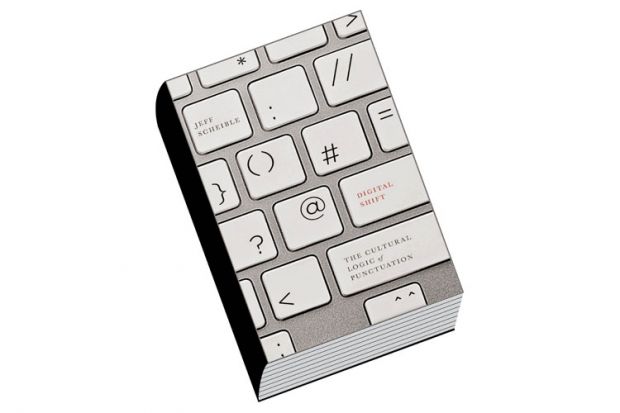Punctuation is important. From hieroglyphics to Chinese characters to #milifandom, societies have relied on typographical marks to convey meaning. Often these marks go undetected, seamlessly shaping and controlling the culture. Sometimes they matter more than they should: how much ink has been spilled over the Oxford comma? Sometimes they do not matter enough: only this year has Apple finally diversified its emoticons. These systems of writing, indicators of belief and badges of honour can be found across our culture. They give us power, literally at our fingertips, to make or break someone’s day. In short, they matter, and here Jeff Scheible tells us why.
Digital Shift: The Cultural Logic of Punctuation examines the proliferation of these signs and symbols in our world. Drawing on a wide range of texts, Scheible describes the present condition of contemporary culture through a typographical lens. There is useful history and theory here, but it goes beyond the explanatory. By using pertinent case studies, mainly from film (notably Adaptation, Me and You and Everyone We Know and I Love Alaska), he draws attention to the aesthetics, ideologies and radical potential of punctuation in our digital age.
The first two punctuation marks that Scheible analyses in detail are the “period” (the full stop to Brits) and the “parenthesis”. The period is surely the Mafia overlord of punctuation marks: its ubiquitous firm presence, helpful indication to breathe when reading aloud and “dot” in the “dot-com” all point towards a character that knows it’s the boss. Its spherical shape conjures images of completeness. However, Scheible suggests that the period may no longer inscribe finality across visual culture. Its role is shifting: “ongoing, architectural, and less conclusive”.
The parenthesis serves as another lens to assess shifts in digital media. Scheible describes its playful, elusive nature: parentheses are often “floating signifiers, helping both to manage and complicate information”. Academia and popular culture’s play with parentheses is examined, and Scheible suggests that while the marks can “embrace and connect”, they also unearth “the loneliness, anxieties and fears” of a new age. This is a trait of the book: for every argument it makes, it also generously offers counter-arguments.
Although Scheible also considers the hashtag, it is a shame that he does not broaden this analysis to include more such symbols. Nevertheless, his narrow focus demonstrates the scope there is to say a lot about little things. Although this book will date as fast as the technological age advances, its core interrogation of textual dynamics and the mapping of cultural codes will remain useful for a long time.
This is an engaging read, neither overly long nor unnecessarily dense. Like an emoticon winky face on a bad day, it really does show that it is the little things in life that make a difference. Just as the spherical period can be seen as a “synecdoche for the world”, this book’s ambitious reach is a synecdoche for the global anxieties over how to convey meaning in our modern age. It would be wise for academia to not forget what microscopic textual marks relay to us. With that in mind, this review should really end thus: @jeffscheible: (☺) = #<3yourbook!
Poppy Corbett is visiting lecturer in creative writing, Royal Holloway, University of London.
Digital Shift: The Cultural Logic of Punctuation
By Jeff Scheible
University of Minnesota Press, 176pp, £52.50 and £15.00
ISBN 9780816695737 and 5744
Published 1 June 2015
后记
Print headline: Little things mean a lot
